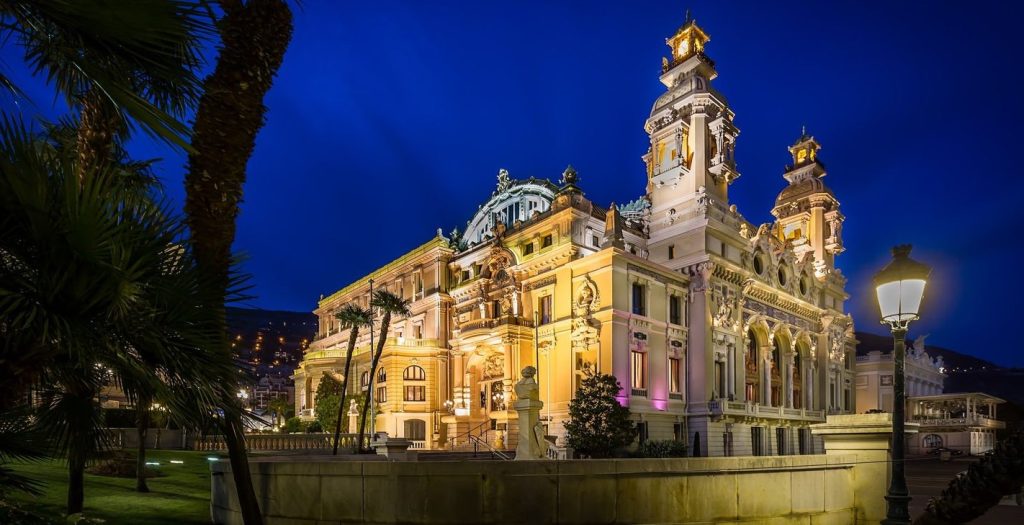Casino de Monte-Carlo: Nestled in the heart of Monaco, the Casino de Monte-Carlo is one of the most iconic and luxurious gambling establishments in the world. This 19th-century architectural marvel is not only a casino but also a cultural and historical symbol of European elegance and high society. For over a century, it has drawn royalty, celebrities, gamblers, and tourists alike, fascinated by its grandeur, games, and legacy.
Casino de Monte-Carlo: Location and Setting
Casino de Monte-Carlo: The Casino de Monte-Carlo is located in the Principality of Monaco, a tiny sovereign city-state on the French Riviera. Specifically, it sits in the district of Monte Carlo, which is world-renowned for its glamour, Formula 1 races, and the opulence of its clientele.
Casino de Monte-Carlo: Geographic Information
| Feature | Description |
|---|---|
| Country | Monaco |
| District | Monte Carlo |
| Address | Place du Casino, 98000 Monaco |
| Coordinates | 43.7396° N, 7.4276° E |
| Nearby Landmarks | Hôtel de Paris, Café de Paris, Monaco Port |
Casino de Monte-Carlo: The casino offers a stunning view over the Mediterranean Sea, framed by palm trees, marble fountains, and luxury vehicles parked at its entrance.
Historical Background
The Casino de Monte-Carlo was established in the mid-19th century as a means to save the Grimaldi family from financial collapse. It quickly grew into a European hub of entertainment and gambling.
Key Historical Events
| Year | Event |
|---|---|
| 1856 | The first gaming house opened in Villa Bellevu, Monaco. |
| 1863 | Prince Charles III granted a 50-year concession to François Blanc, a French businessman, to develop and manage the casino. |
| 1865 | The current site in Monte Carlo was chosen, and construction began. |
| 1879 | Architect Charles Garnier (designer of Paris Opera House) redesigned parts of the building, adding theatrical flair. |
| 1950s–Present | Casino becomes a fixture in popular culture and film (e.g., James Bond). |
Architecture and Design
The design of the Casino de Monte-Carlo reflects Beaux-Arts architecture, marked by ornate decorations, high ceilings, and opulent materials like gold, marble, and crystal chandeliers. It combines elements of a palace with a theatre, fitting for a venue that was built not only for gambling but also for operatic performances and royal galas.
Architectural Details
| Feature | Description |
|---|---|
| Architects | Charles Garnier, Jules Dutrou |
| Style | Beaux-Arts / Belle Époque |
| Interior Highlights | Salle Garnier (opera hall), gaming salons, marble columns, ceiling frescoes |
| Gardens | French-style terraces, sculptures, panoramic Mediterranean views |
The Salle Garnier, part of the casino complex, also functions as the Opéra de Monte-Carlo, hosting world-class performances since its opening.
Casino Games and Amenities
The Casino de Monte-Carlo offers a wide selection of both traditional and modern games. However, entry rules vary: locals from Monaco are not permitted to gamble in the casino under Monaco law. It’s primarily designed for wealthy international clientele.
Table of Casino Offerings
| Game Type | Variants Available | Description |
|---|---|---|
| Table Games | European Roulette, Blackjack, Punto Banco, Trente et Quarante | High-stakes classics in elegant rooms |
| Slot Machines | Classic, Video, Progressive Jackpots | Hundreds of machines available across various rooms |
| Poker | Texas Hold’em, Omaha (tournaments) | Popular with elite players |
| Private Salons | VIP-exclusive areas | Personalized service and ultra-high-stakes tables |
In addition to games, guests can enjoy luxury dining, bars, and access to nearby venues like the Hôtel de Paris Monte-Carlo, which offers spa services, Michelin-star restaurants, and private beaches.
Cultural and Pop Culture Significance
The Casino de Monte-Carlo has appeared in numerous works of popular culture. It’s particularly famous for being associated with the James Bond franchise, enhancing its aura of intrigue and sophistication.
Famous Appearances
| Film/Show | Year | Role of Casino |
|---|---|---|
| Never Say Never Again | 1983 | Bond plays games in iconic casino rooms |
| GoldenEye | 1995 | Scenes filmed on location |
| Ocean’s Twelve | 2004 | Inspired several scenes |
| Madagascar 3 (animated) | 2012 | Parody of the casino |
Additionally, the casino has hosted major social and cultural events, such as fashion shows, royal galas, and art exhibitions.
Economic and Social Role
Though Monaco has a zero-income-tax policy for its residents, the casino contributes significantly to the principality’s public finances.
Economic Contributions
| Category | Impact |
|---|---|
| Tourism | Major attraction for global luxury travelers |
| Revenue | Contributes to Société des Bains de Mer (SBM), a publicly traded company owned partly by the state |
| Employment | Hundreds employed in hospitality, security, gaming, and entertainment |
| Urban Development | Helped transform Monaco into a luxury destination |
Ironically, Monaco’s residents are not allowed to gamble in the casino, a law instated by Prince Charles III to maintain social order and preserve family wealth.
Visiting the Casino Today
Visitors to the Casino de Monte-Carlo must follow certain etiquette and dress codes, especially in the main gaming rooms. While tourists can tour the building in the morning, formal evening wear is required for entry after 8 p.m.
Visitor Information
| Aspect | Details |
|---|---|
| Opening Hours | Tours: 10 a.m. – 1 p.m., Games: From 2 p.m. onward |
| Dress Code | Elegant attire; jackets and ties preferred |
| Entry Fee | Around €18 for general visit; games may cost more |
| Photography | Restricted inside gaming rooms |
| Age Limit | Minimum 18 years, ID required |
Conclusion
The Casino de Monte-Carlo is more than just a gambling destination—it’s a living piece of European history. With its blend of art, architecture, entertainment, and elite society, it represents the pinnacle of old-world glamour fused with modern luxury.
Whether you’re a history buff, architecture enthusiast, or high-rolling gambler, the casino offers a timeless experience like no other.

